
Sometimes you just get lucky. The weather in Eastern England last week was horrible: freezing temperatures, fierce winds, frost, sleet and even snow. At the start of the week I spent two nights at Blakeney on the North Norfolk coast, in prime birding country. On my first morning, a post-dawn walk produced an unexpected encounter with a Woodcock, fresh in from the North Sea, and the memorable sight and sound of great skeins of Pink-footed Geese flighting high over the saltings as they headed inland to feed.

Long-tailed Tit
It was a fine start to the day, and I spent the hour after breakfast searching the tit flocks in nearby Wells Wood for migrants – both Yellow-browed and Pallas’s Warblers had been reported. The Long-tailed Tit flocks had a few Goldcrests tagging along with them, and once I glimpsed a Firecrest, enjoying a momentary surge of excitement as I spotted its bright black and white eye stripe.

Spot the Goldcrest. Considerable numbers of these tiny birds (Britain’s smallest) migrate across the North Sea to England every autumn
Both the ‘crests were almost certainly migrants from Scandinavia. Quite how such tiny birds manage such extraordinary feats of migration is a mystery. It was once thought that they hitched rides on the back of bigger migrants, such as Short-eared Owls and Woodcock. In Yorkshire, the Goldcrest was once known as the Woodcock’s Pilot, though it’s also claimed that they gained the name because the first birds of the autumn would arrive on the coast a couple of days before the first Woodcock.
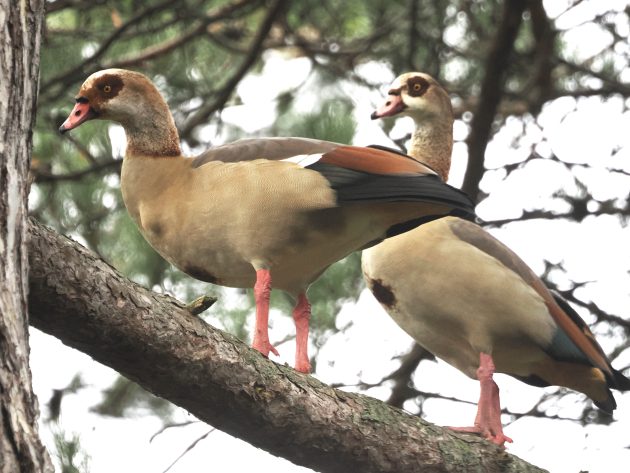
A pair of noisy Egyptian Geese in the top of a Scots Pine. None of our native geese would dream of perching in a tree
The most unlikely encounter in the wood (a long, mature belt of pine trees that backs the beach) was a pair of Egyptian Geese, noisily braying from the top branches of a Scots Pine. These African geese have been established in Norfolk since the middle of the 19th century. A goose in a tree in the middle of a wood sounds improbable, but Egyptian Geese are strange birds.

Greylags, Canadas and Pinkfeet feeding together on sugar-beet tops. The geese perform a service for the farmer by eating the tops before the beet is harvested
As the day wore on the weather deteriorated, giving way to an unpleasantly soggy afternoon. I’d put the camera away as the light was now so bad, but I couldn’t resist taking a few shots of a great army of geese feeding on sugar-beet tops. All the closest birds to me were Greylags and Canadas, but they were hugely outnumbered by many hundreds of Pinkfeet, feeding out of range of the camera.
On my second morning the morning dawned so foul – lashing rain, biting wind – that my spaniel Emma decided that it was simply too horrible to be out walking. After a mere 100 yards she stopped. If she could have spoken, her words would almost certainly have been “why are we doing this?” I gave in and we beat a retreat back to shelter.
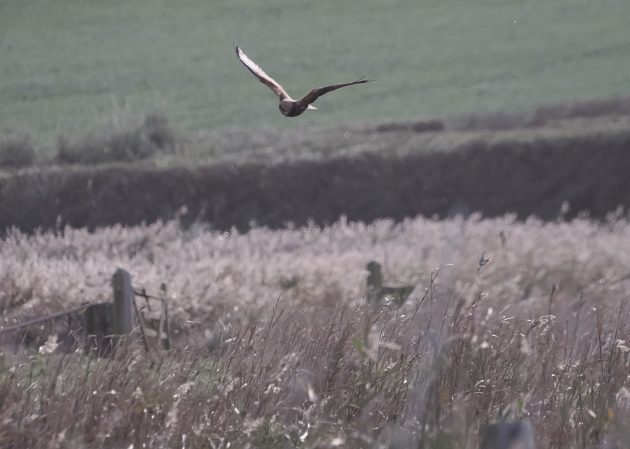
Marsh Harrier over the reeds at Cley

A single Dark-bellied Brent Goose at Cley
Later that morning when the rain had stopped I spent an hour in the hides at Cley, a Norfolk Wildlife Trust reserve and one of the most celebrated birding sites in Britain. The birds clearly didn’t like the weather, either, as I saw little apart from the usual wildfowl and Marsh Harriers. The only bonuses were a fleeting glimpse of a Water Rail and a long look at a sleeping Jack Snipe. Though only a few yards away, the snipe was extraordinarily difficult to see, and wasn’t worth pointing my camera at.

The partly flooded shingle south of Lowestoft – perfect habitat for larks and buntings
If you’ve read this far, you may be wondering where the luck was that I mentioned in my first sentence. Well, that came on Thursday when I’d arranged an excursion with my birding pal Andrew. Though it was a bitterly cold start to the day, the sun shone from dawn to dusk, so we were lucky with the weather. We were, too, with the birds. A report of both Shore Larks and Snow Buntings on the Suffolk coast, south of the unlovely town of Lowestoft, was sufficient to tempt us east (Lowestoft is the eastern-most town in Britain).
We knew where to find our quarry – on the coast close to Pakefield Coastguards, near to the improbably named Crazy Mary’s Hole – but how to get there was the challenge. Our first attempt, starting from just south of Lowestoft was unsuccessful. The coastal path had fallen into the sea, for the cliffs here are eroding fast, while a rising tide stopped us from walking along the beach. We eventually studied our Ordnance Survey map (Explorer 231) closely, and worked out where we could park the car, and where there was a public footpath that would enable us to reach the beach. We set off more in hope than expectation.

Unexpected bonus: an approachable Grey Wagtail

The area where the larks and buntings were frequenting proved to be an extensive shelf of shingle between cliffs and sea, partly flooded with shallow brackish pools and sparsely vegetated with marram grass and sea buckthorn. A tall wooden staircase allowed us to descend from the top of the cliff to the shore, and our hunt began. The habitat looked promising, but at first we found nothing but Black-headed Gulls and an approachable Grey Wagtail. It was too much to hope that buntings and larks would be as easy to get close to, should we be fortunate enough to find them.

Shore Lark, a scare winter visitor to the shores of Norfolk and Suffolk
Well, after a great deal of trudging along the shingle (I have bad knees, so walking on shingle is a form of mild torture), we eventually met up with a trio of birdwatchers, on their way back from the beach. Yes, they had seen a couple of Shorelarks, but they had flown; however, they assured we should see Snow Buntings as “there was a big flock of them over there”, gesturing to a bleak expanse of shingle half a mile away. We stomped on.

Shore Lark
I’m pleased to report that we hadn’t gone far when we came across the Shore Larks, but not just two, a flock of six. Shore Larks are the very same birds as the North American Horned Lark, Eremophila alpestris. They are scarce winter visitors to the coast of East Anglia, and never easy to find, while numbers visiting us have declined in recent years. We enjoyed watching the birds feeding in the shingle, seldom stopping for long before running on, but always staying close together. I wasn’t prepared to disturb them in my quest for a good photograph, so my pictures were no more than record shots.
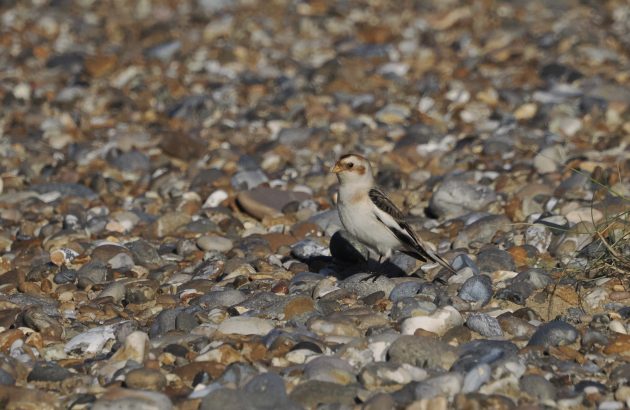
Snow Bunting – a wintering bird rarely found away from the shoreline in East Anglia
It was while we were watching the larks that the Snow Buntings first appeared, flying fast overhead in a tight flock, before disappearing. Minutes later they returned, the males unmistakable as they flashed their striking black and white wings. However, as eye-catching as they may be in the air, on the ground their camouflage is impressive, and you have to look very hard to see them as they feed in the shingle.
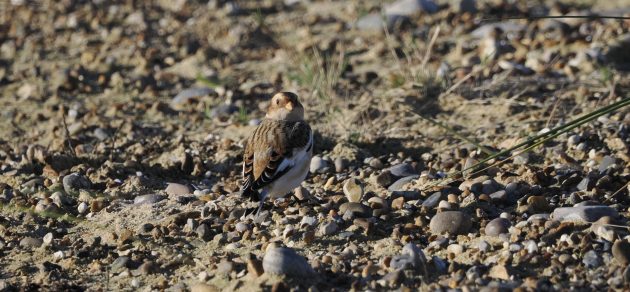
Snow Buntings are beautifully camouflaged and are hard to spot on the shingle
Like Shore Larks, Snow Buntings are winter visitors to East Anglia, and are rarely found away from the coast. The numbers that visit us vary greatly from year to year: this flock of 40 was the biggest I’d seen for some time, while they were also my first of the year, bringing my UK total up to 209 species. It was a long, hard slog back to the car, but it was difficult to stop smiling.
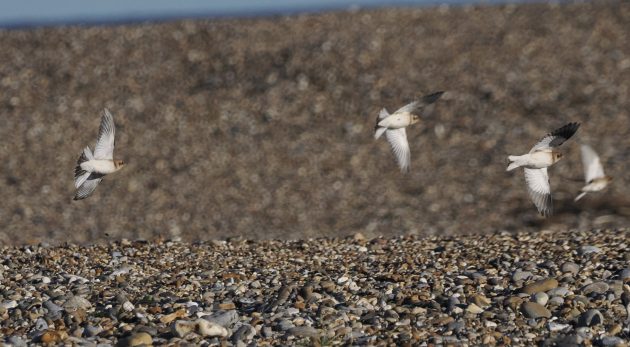



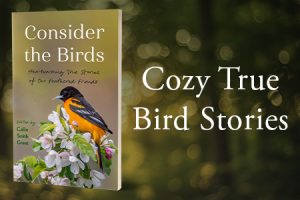


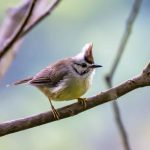


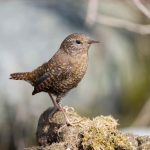

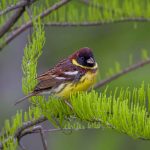

Leave a Comment